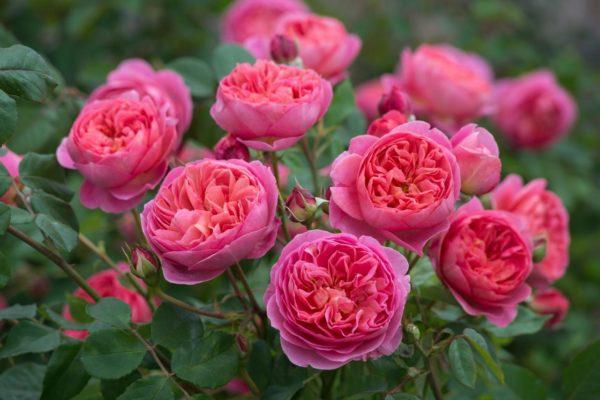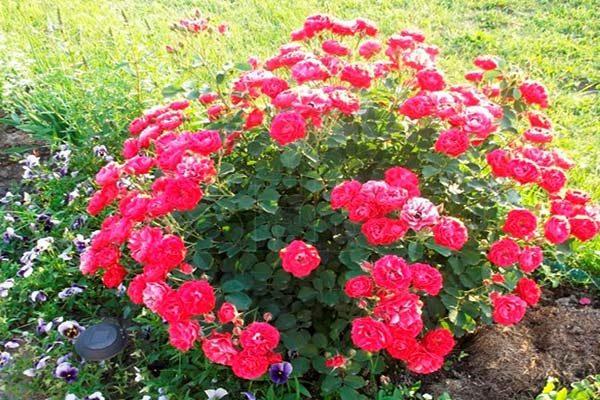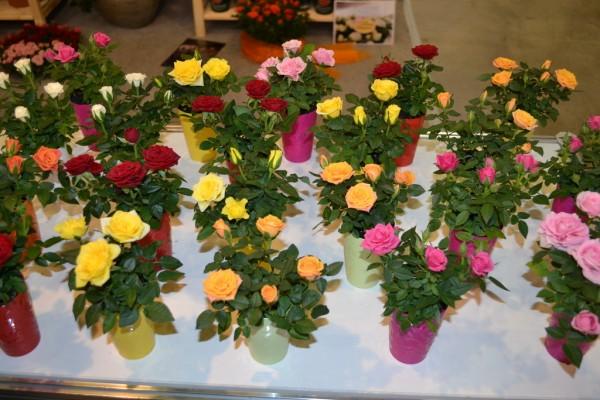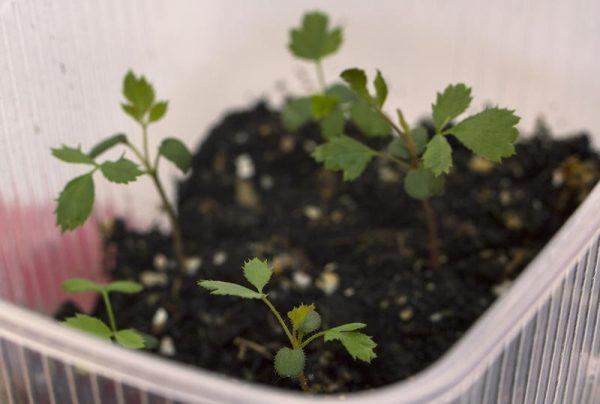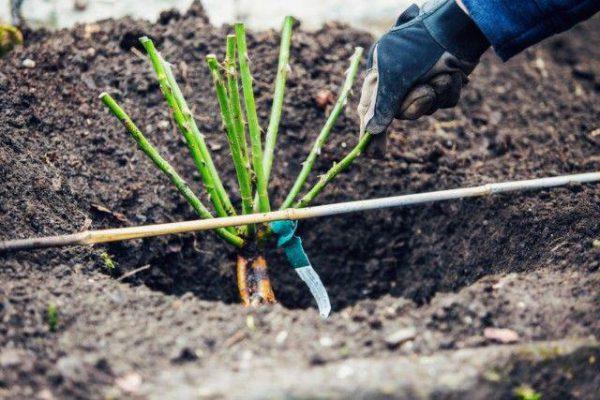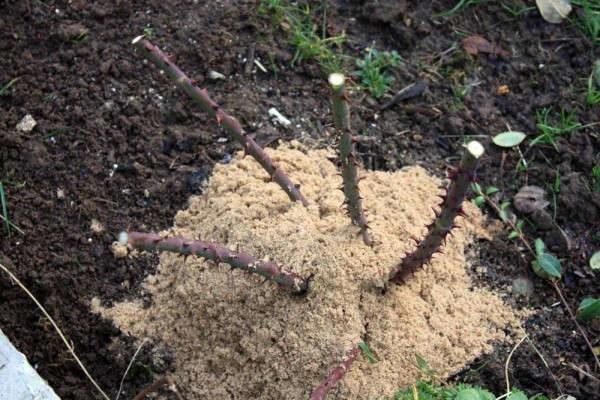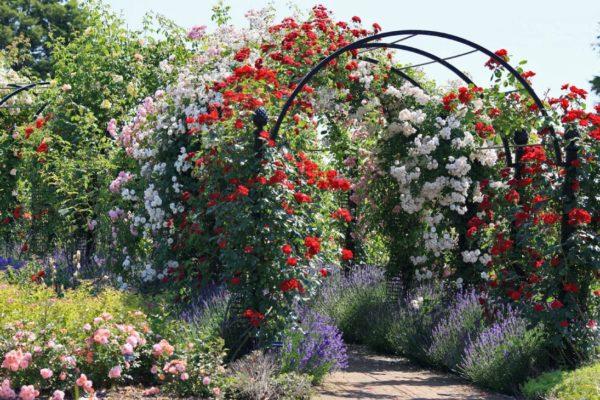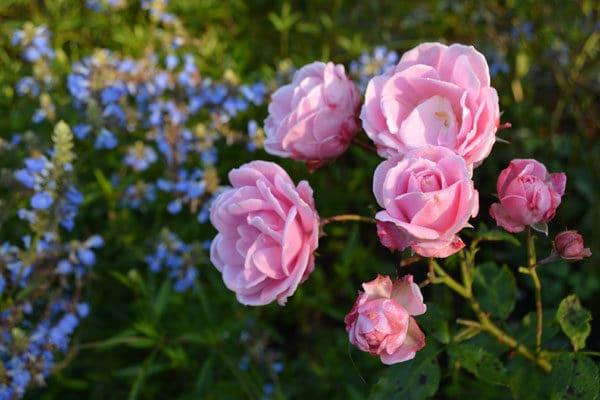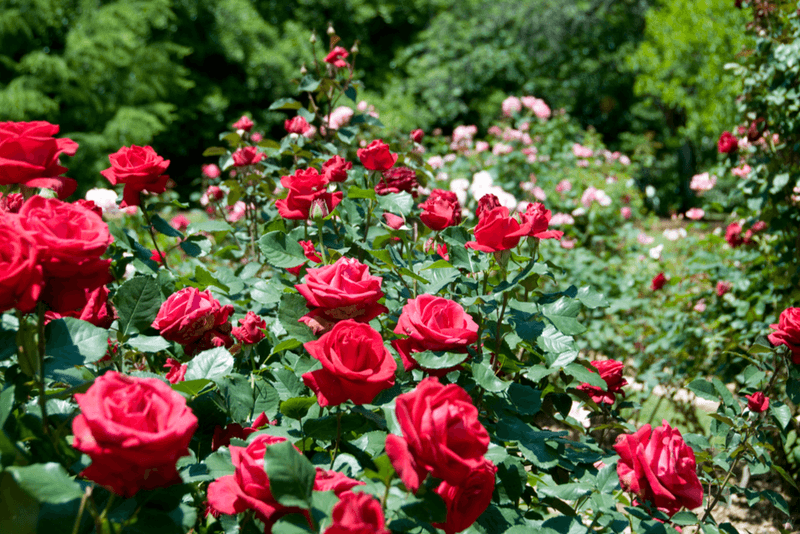The polyanthus rose is most often chosen for its luxurious flowering clusters. They are very similar to the climbing varieties. Thanks to their high decorative qualities, they look impressive in the garden, both solo and in composition. It is not for nothing that they are called multi-flowered - polyanthus; on one plant there are over 40 large inflorescences. To grow gorgeous roses on your site, you need to know their strengths and weaknesses, planting and care features.
- What is a polyanthus rose?
- Peculiarities
- Advantages
- Flaws
- Necessary conditions for cultivation
- Selecting a location
- Required soil composition
- Lighting and temperature
- Humidity
- Rose sowing algorithm
- Collecting seeds
- Stratification
- Preparing for sowing
- Timing and technology of sowing seeds
- Planting crops from cuttings
- Caring for polyanthus rose
- Mulching
- Irrigation
- Fertilizing
- Formative pruning
- Sheltering bushes for the winter
- The best varieties
- Orange Triumph
- Masquerade
- Iceberg
- Angel wings
- Spartacus
What is a polyanthus rose?
The name itself fully characterizes this flowering shrub - the polyanthus rose, which stands out for its compact size, its height is 40-60 centimeters. The leaf mass is quite thick, the flowers are small, bright (3-4 centimeters in diameter), collected in corymbose inflorescences. Their color is predominantly red or pink, but white specimens are also found.
To successfully grow a polyanthus rose, it is very important that in the first year after planting the plant directs all its energy to the growth and development of roots and shoots. Therefore, after planting, young plants need special attention.
Peculiarities
Polyantha roses have a long flowering period. They delight with their luxurious inflorescences almost the entire season. The bushes do not take up much space on the site, look beautiful and are not afraid of temperature changes. The multi-flowered plant is a creeping variety. Resistance to moisture is another feature of the polyanthus rose.
Advantages
Among the positive characteristics of the polyanthus rose, experienced gardeners highlight:
- not demanding on growing conditions;
- resistance to adverse environmental factors;
- high decorative qualities;
- short stature;
- multi-flowered;
- long flowering;
- absence of thorns;
- increased frost resistance;
- high vitality;
- a large number of shoots;
- ability to bloom in the shade;
- increased immunity to fungal infections and major diseases;
- Suitable for beginner gardeners.
Flaws
Despite a whole list of advantages, the polyanthus rose also has its weaknesses, which you should be aware of:
- small range of colors;
- the need to remove faded buds;
- faint fragrance.
It is noteworthy that there are varieties of polyanthus roses with rather unusual colors (salmon, white-pink and violet-purple), but none with yellow buds.
Necessary conditions for cultivation
One of the significant factors influencing the popularity of the polyanthus rose is its unpretentiousness in both planting location and care. It is capable of forming luxurious inflorescences both in the shade and in a well-lit clearing. In order to initially create favorable conditions for growth, you need to know what soil composition is best suited for it, and what area is best allocated for it.
Selecting a location
For polyanthus roses, a clearing with a good level of light is preferable. The bushes should not be exposed to cold air currents - drafts and northern winds. Shady areas for planting polyanthus rose bushes can also be considered, but here there is a high probability of shoots stretching.
Required soil composition
For rose bushes, the best option would be to plant them in light loamy soil, where there is a sufficient level of moisture and air permeability. Planting in sandy soil is not advisable, since in such places the roots of the plant can freeze and overheat in summer. In addition, useful components are quickly washed out of such soils. Chalky soils are bad for rose bushes.
The multi-flowered plant is able to grow and develop on acidified soils, but it is desirable that the selected area for planting bushes has a neutral degree of acidity.
Lighting and temperature
Polyanthus roses attract gardening enthusiasts with their cold resistance; they can be grown even in central Russia, in Siberia. The area for planting seedlings should be well lit, the light should be diffused.
To be safe for the winter, polyanthus roses, especially young ones, are recommended to be covered.
Humidity
When deciding on the area, you should not consider areas with high humidity levels. On marshy soils, the rose garden will often get sick. Lowlands are also unsuitable for such plants.
Rose sowing algorithm
In order to grow a plant while maintaining all the qualities of the parent bush, you need to become more familiar with the main points of sowing work.
Collecting seeds
It is recommended to select seed material in August, when most of the buds have already bloomed. For these purposes, not quite ripe seed pods are selected, and the skin is carefully opened so as not to damage the seeds. They are poured onto a suitable surface and separated from the remaining pulp. For sowing, only strong specimens are used, which are disinfected in a low concentration solution of potassium permanganate.
Stratification
An artificial option for seed interlayering involves the following steps:
- Soak a cloth in hydrogen peroxide.
- Place seed on it.
- Cover it with another layer of napkin.
- Place the seeds, wrapped in cloth, in a plastic bag.
- They sign.
- Place the layer in the refrigerator where vegetables are stored.
- Periodically, the seeds are taken out and inspected.
If moldy seeds are found, they should be replaced with new ones. The first shoots can be observed after 2 months from the beginning of stratification.
Preparing for sowing
Before planting seeds, it is necessary to prepare both the container and the substrate. It is best to use cassette options for seedlings or wide containers (containers), peat tablets, and personal cups. When sowing in a common container, the sprouts should then be pricked, which is not entirely suitable for the delicate roots of roses.
The soil substrate used is universal soil for seedlings, which can be purchased at any specialized retail outlet.
Timing and technology of sowing seeds
Considering the difficulty of seed germination, work should begin early - in January-February. The algorithm for planting seeds in the ground provides:
- Filling the container with universal soil for seedlings.
- Forming holes in a common container at a distance of 3 centimeters from each other.
- Bury the seeds to a depth of 0.5 centimeters.
- Sprinkle them with loose soil and perlite.
- Moisturizing with a spray bottle.
- Creating a mini-greenhouse using a transparent polyethylene lid.
Crops need to be ventilated periodically, condensation removed and irrigated. The first sprouts of the polyanthus rose will appear in a month, when they are crowded, they are placed in separate cups. The cover is removed after they peck.
Planting crops from cuttings
The cutting method is quite effective and can be done by beginners. You need to cut cuttings 15 centimeters long and soak them in a growth stimulant solution for 24 hours. After which, they are placed in a container filled with a soil mixture of peat, perlite, sand and sawdust that have been disinfected. They are also covered with cut plastic containers to create greenhouse conditions.
After 2-3 weeks, the cuttings of the polyanthus rose will have roots.The shelter is removed and they are transplanted into deeper containers. You can feed polyanthus roses with complex fertilizer. They are planted in a designated place in the garden the following year.
Caring for polyanthus rose
Caring for bushes is not so difficult, the main thing is to irrigate in a timely manner, add nutrition, prune and cover for the winter.
Mulching
To preserve moisture and protect from overheating, the soil under polyanthus roses needs to be mulched. Pine needles, straw or sawdust are used for these purposes.
Irrigation
During the dry season, irrigation activities should be carried out every 2-3 days. Water needs to be poured at the root. In cold weather, watering should be avoided.
Fertilizing
Any complex fertilizer for roses is suitable for surface treatment. Leaf feeding does not take much effort and time, but the result of their use is simply excellent: the buds grow large in size and brightly colored. In addition, there is no danger of spoiling the soil with mineral compounds under polyanthus roses.
And under the root, rotted manure or humus is used.
The working solution is prepared at the rate of 1 part organic fertilizer and 20 parts clean water. Positive results are obtained by mulching the soil under the bushes with humus, where 1 bucket of the product is used per 1 square meter.
Formative pruning
The procedure is carried out at the flowering stage, removing already faded inflorescences. In the fall, you need to shorten all the shoots by ½ to make it more convenient to cover them for the winter. With the arrival of spring, shoots that have been exposed to frostbite or disease are pruned. The darkened areas are cut out to healthy tissue.
Sheltering bushes for the winter
First, the shoots are shortened by half, the root collar is sprinkled with soil to a height of 30 centimeters.When grown in the northern regions, fallen leaves, straw, and non-woven material are used to cover the bushes. When warm weather sets in in the spring, the cover of polyanthus roses is removed, and the root collar is freed from the ground after the threat of night frosts has passed.
The best varieties
Among the most popular and well-proven varieties of polyanthus roses, plant growing enthusiasts note: Orange Triumph, Masquerade, Iceberg, Angel Wings, Spartak.
Orange Triumph
This variety of polyanthus rose has an intensive growth rate, its height is 60-90 centimeters. The bush produces luxurious double flowers 3-5 centimeters in diameter, which are collected in chic brushes, green leaf plates with a glossy surface. One flower has almost 60 petals, their color is salmon-red with an orange tint. The rose looks quite elegant; up to 50 roses open simultaneously on one shoot.
Masquerade
The bush is distinguished by its tall growth and resistance to major ailments. The height of the plant does not exceed 70 centimeters, the color of the leaf mass is dark green. Roses are produced in large sizes, they are loose and have a pleasant scent. Up to 5 pieces are formed in one inflorescence. The flowering of the polyanthus rose is long and abundant, the color is first yellow and then pale crimson.
Iceberg
The plant belongs to the bush type, its height is 60-80 centimeters, the flowers are 5-7 centimeters in diameter. The polyanthus rose attracts attention with its snow-white flowers, which last a long time, both on the bush and as a cut flower. The shoots are erect, the light green leaf blades have a glossy surface. The variety is distinguished by repeated flowering, from July to September.
Angel wings
The bush (30 centimeters in height) has a neat appearance, its flowers reach 5-6 centimeters in diameter, and they are painted light pink. There are several varieties: non-double, where the number of petals in flowers is 10-15 pieces, and double - up to 25 pieces. One brush can contain up to 15 highly fragrant roses. Flowering is almost continuous until the onset of cold weather.
Rose variety Angel Wings Can be propagated both by seed and by cuttings. It is chosen primarily for creating spectacular group compositions. They look especially advantageous when planted on lawns, along the sides of roads and sidewalks. Due to its high decorative characteristics, the plant fits perfectly into the design of terraces, balconies and verandas.
Spartacus
The polyanthus rose belongs to the tall plants, its height is almost 80 centimeters. A distinctive feature of the Spartak variety is its very large flowers, which also stand out for their beautiful shape and red color. There are also specimens with orange buds, which makes the bush even more impressive.
The polyanthus rose is truly a luxurious and graceful plant. Bushes are actively used in landscape design; they can be planted as individual garden decorations or in combination with other flower crops; they look especially harmonious with ears of grass. The main thing is to adhere to the correct agricultural techniques when growing rose bushes and not to ignore methods of protection from low temperatures.

